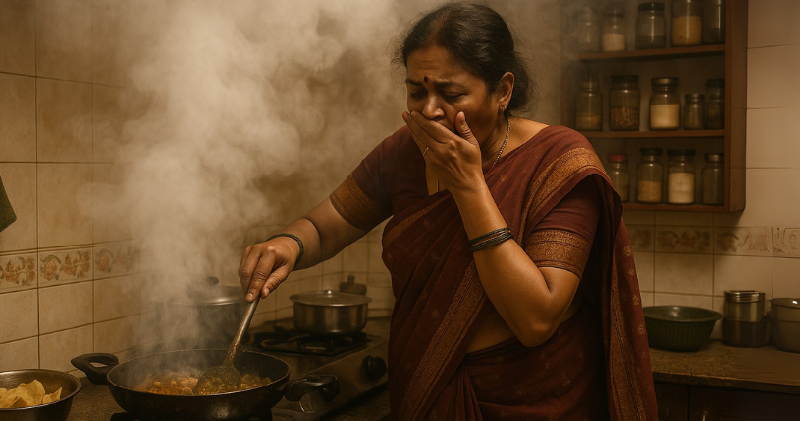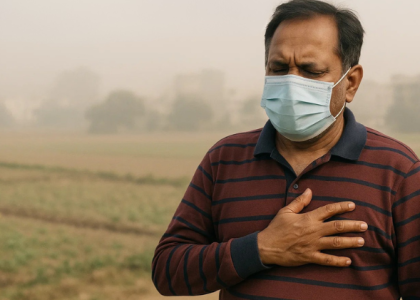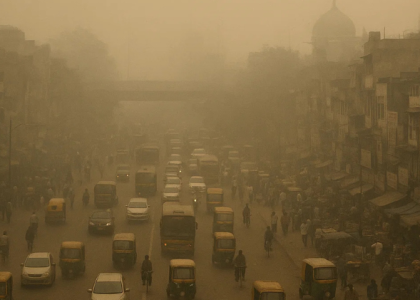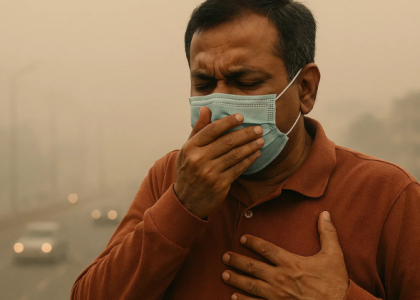Rashmi spent three hours every evening preparing dinner for her family of six. Tadkas, deep frying, roasting spices—all on her trusty gas stove. Her kitchen had no exhaust fan. She took pride in her elaborate home-cooked meals.
But after years of daily cooking marathons, Rashmi developed a persistent cough. She felt tired all the time. Her doctor ran tests and found something puzzling.
Her CRP was 4.2—showing dangerous inflammation in her body.
“Do you smoke?” the doctor asked. “No,” Rashmi replied. “Are you exposed to air pollution?” Again, “No.” Then Rashmi mentioned her daily cooking routine. The doctor’s face changed.
“Gas stoves without proper ventilation release toxic gases,” he explained. “After years of breathing these fumes, your heart is under attack.” Rashmi was shocked. The kitchen where she lovingly prepared healthy meals was actually harming her heart every single day.
Her story isn’t unique. Millions of South Asian women spend hours daily cooking over gas flames in poorly ventilated kitchens. They’re unknowingly exposing themselves to pollutants that increase heart disease risk.
What Science Says About Gas Stoves and Heart Health
Gas stoves aren’t just cooking tools. They’re indoor pollution sources that release dangerous compounds into your breathing space.What Gas Stoves Actually Emit
- Nitrogen Dioxide (NO₂): A toxic gas that inflames your airways and blood vessels.
- Carbon Monoxide (CO): Reduces oxygen in your blood and forces your heart to work harder.
- Fine Particles (PM2.5): Microscopic particles that enter your bloodstream and reach your heart and brain.
- Formaldehyde: A cancer-causing chemical that also harms your cardiovascular system.
How These Pollutants Attack Your Heart
- Direct inflammation of blood vessels
- Oxidative stress damaging artery walls
- Chronic blood pressure elevation
- Heart rhythm problems
Key Research Findings
- Harvard study: 32% higher heart disease rates with gas stoves vs electric.
- China: Gas stove use led to inflammation similar to moderate smokers.
- India: Daily gas stove use for 10+ years doubled heart disease risk.
Why South Asians Are Especially at Risk
- We cook more frequently and for longer durations.
- High-heat methods like tadkas and frying release max pollutants.
- Poor kitchen ventilation traps toxic gases.
- Women, who do most cooking, face greatest exposure.
Warning Signs Cooking Pollution Is Harming You
- Persistent cough, shortness of breath, sore throat
- Fatigue, chest tightness, elevated blood pressure
- High CRP levels, frequent infections
- Family members showing similar symptoms
Solutions to Protect Your Heart
1. Install Proper Ventilation
- Range hood (min. 100 CFM) vented outside
- Clean/replace filters regularly
- Use highest fan setting during cooking
- Open windows, use cross-ventilation
2. Clean Your Kitchen Air
- Use HEPA air purifiers rated for your kitchen size
- Run during and after cooking
- Add air-purifying plants
3. Modify Cooking Methods
- Use medium heat
- Reduce active cooking time
- Use pressure cookers, one-pot meals
4. Consider Electric or Induction Appliances
- Induction cooktops produce no combustion gases
- Use electric pressure cookers, air fryers, griddles
Implementation Plan
- Month1: Open windows and use fans.
- Month2: Add HEPA purifier.
- Month3: Try portable induction burner.
- Long-Term: Install proper range hood.
Action Steps
- Ventilate kitchen now: open windows, install or use fan
- Test air quality with affordable monitor
- Switch to medium heat, use fewer burners
- Start with electric/induction appliances if you can
- Ask your doctor to test CRP if you cook often
Frequently Asked Questions
Q: I’ve cooked with gas for years and feel fine—why worry? A: Chronic exposure damages the heart slowly. Get your CRP tested and improve ventilation to be safe. Q: Are electric stoves really better? A: Yes. They produce no harmful combustion gases. The science supports switching where possible. Q: I rent and can’t install a hood. What now? A: Use a HEPA purifier, open windows, and try portable induction burners to reduce exposure.References
- Seaman, V.Y. et al., Environmental Health Perspectives.
- Dennekamp, M. et al., Occupational and Environmental Medicine.
- Lin, W. et al., Atmospheric Environment.
- Belanger, K. et al., American Journal of Epidemiology.
- Zhao, Y. et al., Environmental Health Perspectives.
- World Health Organization, Household Air Pollution and Health.
- Brook, R.D. et al., Circulation.




